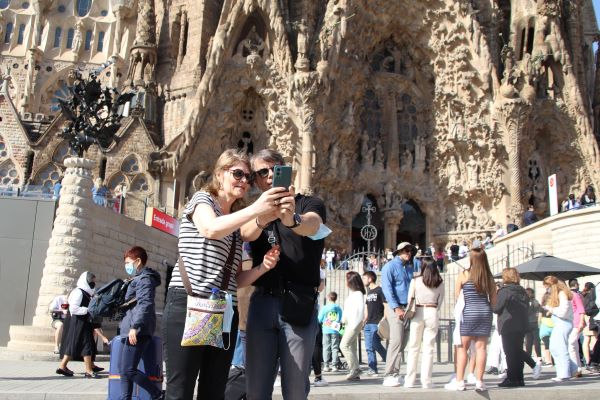UNESCO World Heritage Sites in Barcelona
Catalan capital has 9 modernist sites distinguished for their architectural value, created by Antoni Gaudí and Lluís Domènech i Montaner

Barcelona is home to nine UNESCO World Heritage sites, chosen for their outstanding architectural value. They are divided into two categories, each the work of a modernist architect that left an invaluable mark on Catalonia and its culture.
Seven of the nine sites are the works of the legendary Antoni Gaudí, including some of the most famous tourist attractions in the world, while the other two or from his contemporary Lluís Domènech i Montaner.
UNESCO “seeks to encourage the identification, protection, and preservation of cultural and natural heritage around the world considered to be of outstanding value to humanity,” according to the organization’s website. The sites have legal protection given by an international body and are judged to contain "cultural and natural heritage around the world considered to be of outstanding value to humanity."
Sagrada Família
Antoni Gaudí’s famous unfinished basilica is the legendary architect’s absolute masterpiece. It’s been described as the ‘Bible made of stone’, telling the story of Jesus Christ along its sides.
It’s important to note that only parts of the structure are considered a UNESCO World Heritage site – those completed by Gaudí, who died in 1926 – the work on the Nativity façade as well as the Crypt.
Park Güell
Park Güell is a garden area located in the hills hanging over the city of Barcelona with plenty of architectural elements worth exploring. The centerpiece is undoubtedly the famous multicolored mosaic salamander, but there are plenty of other gems such as the serpentine bench, the columns that surround mosaic ceiling tiles, viaducts, and splendid views of Barcelona to enjoy while there.
Palau Güell
The Palau Güell is a mansion located in the city center, just off La Rambla boulevard. Its facade is decorated in the unmistakable modernist style of Gaudí with curved iron gates and lavish ornamentation, including a phoenix bird sitting on a helmet. The interior is centered around the main room that was once dedicated to entertaining guests from high society.
Casa Batlló
Casa Batlló is another world-renowned masterpiece of Gaudí’s, without a doubt. With bony-looking windows and balconies, some say the facade even resembles a lake with water lilies floating on the water's surface. A blue central light well, a dragon design on the roof, and its stained glass window make it a must-see.
Casa Milà
Casa Milà is also known as La Pedrera – meaning “the quarry” – owing to its stone-colored sandy look. Not a single wall in this building is perfectly straight, but winding and curvy instead, with a very wavey exterior. The facade is filled with small detail, like much of Gaudí’s works, and some residents still live in apartments in the building.
Casa Vicens
Casa Vicens was Gaudí’s first major work in Barcelona. Adorned with vivid green and white checkered tiles near the top, interspersed with red brick, the uniquely shaped structure is decorated with many motifs inspired by nature. Its style is less modernist, but more associated with oriental or Neo-Mudéjar architecture.
Colònia Güell and Gaudí’s Crypt
Perhaps Antoni Gaudí’s best-kept secret lies just a short train journey outside Barcelona. Colònia Güell was a company town built around the end of the 19th century for textile workers to live and work. Many architects played a part in constructing the fascinating small village that combined utility, labour, and comfort, as the people there all lived and worked in a relatively small concentrated area.
Antoni Gaudí’s contribution to the site was his crypt, the building that was to become a larger church, however, construction was never completed. The end result is a small church designed with many of the hallmarks of the Sagrada Família. Visitors can clearly see the influences and styles the architect used on both landmarks. Had work been finished on the crypt, it would have become a “monumental model to the Sagrada Família,” according to Gaudí himself.
Palau de la Música Catalana
Designed by Lluís Domènech i Montaner, the Palau de la Musica Catalana art nouveau concert hall is a gorgeously elaborate structure full of light and space that plays host to some of the most important musicians in the world. The Palau features architectural techniques that were cutting edge for its time, including the reticular steel frame that fills the space with natural light. At the center of the sained glass ceiling roof is an inverted dome skylight, representing the sun shining, adding more light and helping with the acoustics of the room.
Modernist enclosure of Hospital de Sant Pau
The old Hospital de Sant Pau served as a fully functioning hospital until 2009, when a new site was built nearby, allowing the architectural marvel to stand out on its own. It’s exceptionally interesting as a hospital for its size, beauty, and unique design, comprised of 12 pavilions that now serve as a museum and cultural center. The modernist old hospital was also designed by Domènech i Montaner, one of the two UNESCO World Heritage Sites in Barcelona not created by Gaudí.
Listen to our Filling the Sink podcast episode published on July 16, 2022 to learn more about UNESCO sites across Catalonia.